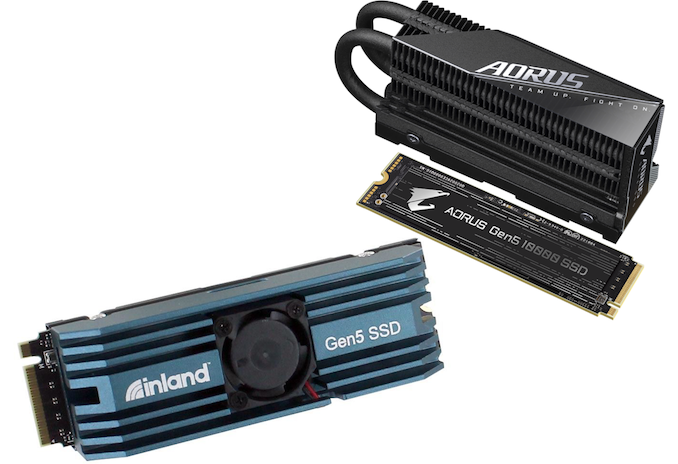
This week, consumer-grade PCIe 5.0 M.2 drives have finally hit the U.S. market, well over a year since the first client PC platforms supporting PCIe Gen5 became available. The new drives offer higher performance than the flagship PCIe 4 drives they supplant, albeit with some trade offs such as high prices and a greater need for good cooling. Meanwhile, for better or worse, the current crop of drives are largely interim solutions; as faster NAND becomes more readily available later this year, drive vendors will be able to push out even speedier drives based on the same controllers.
Up to 10 GB/sec Now for $170/TB
Gigabyte and Inland (a Micro Center brand) are the first companies to offer PCIe Gen5 consumer SSDs in the U.S. Gigabyte's Aorus Gen5 10,000 and Inland's TD510 drives come in a 2TB configuration and are rated for a maximum sequential read speeds of 10GB/sec and maximum sequential write speeds of 9.5GB/sec. Compared to the 7GB/sec or so limit of high-end PCIe 4 drives, this is a notable improvement in sequential read speeds for the same form factor.
Both drives are based on Phison’s PS5026-E26 controller (Arm Cortex-R5 cores, special-purpose CoXProcessor 2.0 accelerators, LDPC, eight NAND channels with ONFI 5.x and Toggle 5.x interfaces at up to 2400 MT/s data transfer speeds) as well as 3D TLC NAND memory. To sustain high performance levels even under high loads, Gigabyte equipped its SSD with a massive passive cooling system with a heat pipe.
Whereas Gigabyte has built their own drive, the drive that Inland/MicroCenter sells is thought to be made by Phison itself (or at least under its supervision). The company not only offers turn-key solutions featuring controllers with firmware and reference design, but can also produce actual SSDs and let its partners resell them under their own brands. Compared to the Gigabyte drive, the Inland drive comes with a rather compact cooling system, but this one is equipped with a small fan that is expected to produce a decent bit of noise (as small fans are wont to do).
Since these are the first PCIe Gen5 SSDs for client PCs on the market and they carry 2TB of raw 3D NAND memory, it is not surprising that they are quite expensive. Amazon and Newegg charged $340 per drive, but quickly sold out the units they had. Micro Center offers its product for $399, but with an immediate $50 discount it can be obtained for $349 once it back in stock.
But Faster Drives Incoming
While these current crop of drives are already hitting 10GB/sec reads, as we often see for first-generation products, they are still leaving performance on the table. Because the NAND needed to make the most of the Phison E26 controller has only recently become available (and only in small quantities at that), these initial drives, as fast as they are, are being held back by overall NAND throughput.
After Phison formally introduced its PS5026-E26 controller in September, 2021, it demonstrated prototypes E26-powered SSDs with 12.5 GB/s reads and 10.2 GB/s writes for a number of times. In fact, a number of the company's partners, such as MSI, even announced E26-based drives with similar performance characteristics, but Gigabyte's Aorus Gen5 10,000 and Inland's TD510 instead start things off a bit slower.
Under the hood, with 8 channels of NAND to pull from the E26 controller needs NAND running at 2400 MT/s in order to saturate its own internal throughput. These data rates, in turn, only recently became available via NAND built to the new Toggle NAND 5.0 and ONFi 5.0 standards. Micron's ONFi 5.0 232-layer 3D TLC NAND chips were used for Phison's prototype drives, but while Micron is slowly ramping up production of 232-layer NAND in general, the company slowed the ramp of 232-layer NAND running at 2400 MT/s. Meanwhile, Phison has yet to validate SK Hynix's 2400 MT/s NAND with its controller.
As a result, due to scarce availability of 2400 MT/s NAND, SSD makers have to use 1600 MT/s NAND with their PCIe Gen5 SSDs for now. Once faster NAND is more readily available, they can start using them to build E26-based drives that will be able to hit 12.3 GB/sec and make the most of the E26 controller, surpassing the performance of this initial generation of drives.







